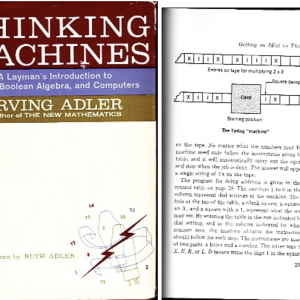博文
图灵机走向大众(Charles Petzold)
||
许多为普通读者撰写的“计算机工作原理”书籍都包含对图灵机的讨论,我从未真正明白这一点,尽管图灵机非常适合研究可计算性概念,但我认为它对理解计算机的实际机制毫无帮助,这就是为什么我没有在自己的“计算机工作原理”一书中即《代码:计算机硬件和软件的隐藏语言》,对图灵机进行深入讨论。
现在我要弥补这一点,我即将出版的书《 The Annotated Turing》全是关于图灵机的,包括这个小发明如何从稀薄的数理逻辑领域中脱颖而出,成为理解我们自己和我们所处的宇宙的工具。
但这是怎么发生的?谁首先想到了图灵机并将其公开给公众?大多数早期的参考资料都是针对相当专业的受众,例如著名的沃伦·麦卡洛克和沃尔特·皮茨 1943 年的文章《神经活动中内在思想的逻辑演算》,诺伯特·维纳 (Norbert Wiener) 在其 1948 年出版的《控制论,或动物和机器中的控制和通信》一书中讨论了图灵的工作,图灵机本身在斯蒂芬·克莱恩 (Stephen Kleene) 的《元数学导论》(1952) 和马丁·戴维斯 (Martin Davis) 的《可计算性和不可解性》(1958) 中占有重要地位,但我对更流行的处理方式感到好奇。
我想知道,图灵机是什么时候第一次出现在一本非数学家或科学家的书籍或文章中?
在探索了我收藏的古董计算机书籍并整理了 Google 图书搜索中出现的内容后,我 95% 确定图灵机首次向公众展示是在 189 页的书《思考机器:外行人对逻辑、布尔代数和计算机的介绍》中,作者是欧文·阿德勒 (Irving Adler),由约翰戴公司 (John Day Company) 于 1961 年出版:
注意封面右下角的真空管!阿德勒将图灵机解释为一种读取和写入笔划的函数计算器,这显然源自克莱恩或戴维斯的书,尽管他的简短参考书目没有列出。
根据维基百科关于欧文·阿德勒的条目,他现年 94 岁,著有 56 本书。更多传记信息显示在此处。
如果有人知道早期的书籍或杂志文章,其中有关于图灵机的讨论,供“外行”参考,我很乐意听听。
原文:
https://www.charlespetzold.com/blog/2007/12/021022.html
The Turing Machine Goes Public
Many "how computers work" books written for a general audience contain a discussion of the Turing Machine. I never quite saw the point of this. Although the Turing Machine is great for examining the concepts of computability, I don't think it helps at all in understanding the actual mechanism of the computer. That's why I didn't include an extended discussion of the Turing Machine in my own "how computers work" book, Code: The Hidden Language of Computer Hardware and Software.
Now I'm making up for that. My forthcoming book, The Annotated Turing is all about the Turing Machine, including how this little invention emerged from the rarefied field of mathematical logic to become a tool for understanding ourselves and the universe in which we find ourselves.
But how did this happen? Who first picked up on the concept of the Turing Machine and disclosed it to the general public? Most of the early references are for rather specialized audiences, such as the famous Warren McCulloch and Walter Pitts 1943 article "A Logical Calculus of Ideas Immanent in Nervous Activity." Norbert Wiener discusses Turing's work in his 1948 book Cybernetics, Or the Control and Communication in the Animal and the Machine, and the Turing Machine itself featured prominently in Stephen Kleene's Introduction to Metamathematics (1952) and Martin Davis's Computability and Unsolvability (1958), but I was curious about more popular treatments.
When, I wondered, did the Turing Machine make its first appearance in a book or article not intended for mathematicians or scientists?
After exploring my own collection of antique computer books and sorting through stuff that turns up in Google Book Search, I am 95% certain that the Turing Machine was first presented to the general public in the 189-page book Thinking Machines: A Layman's Introduction to Logic, Boolean Algebra, and Computers by Irving Adler and published by the John Day Company in 1961:
Notice the vacuum tubes in the lower-right corner of the cover! Adler's explanation of a Turing Machine as a function calculator that reads and writes strokes is apparently derived from Kleene's or Davis's book, although his brief bibliography doesn't list either.
According to the Wikipedia entry on Irving Adler, he is now 94 years old and the author of 56 books. More biographical information appears here.
If anybody knows of an earlier book or magazine article featuring a discussion of the Turing Machine for the "layman" I'd love to hear about it.
https://blog.sciencenet.cn/blog-2322490-1461248.html
上一篇:夏季阅读:《知道太多的人:艾伦·图灵和计算机的发明》(Charles Petzold)
下一篇:艾伦-图灵的贡献(Charles Petzold,2012)
